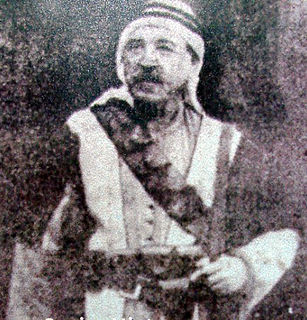 W
WThe Alawite revolt was a rebellion, led by Shaykh Saleh al-Ali against the French authorities of the Occupied Enemy Territory Administration and later as part of the Franco-Syrian War against the newly established French Mandate of Syria, primarily in the coastal Jabal Ansariyah mountain range. The revolt was one of the first acts of armed resistance against the French forces in Syria, and its leader, Shaykh Saleh, declared his allegiance to the provisional Arab government in Damascus. He coordinated with the leaders of other anti-French revolts in the country, including the revolt of Ibrahim Hananu in the Aleppo countryside and Subhi Barakat's revolt in Antioch.
 W
WThe State of Aleppo was one of the five states that were established by the French High Commissioner of the Levant, General Henri Gouraud, in the French Mandate of Syria which followed the San Remo conference and the collapse of King Faisal I's short-lived monarchy in Syria.
 W
WThe Arab Kingdom of Syria was a self-proclaimed, unrecognized state that began as a "fully and absolutely independent... Arab constitutional government" announced on 5 October 1918 with the permission of the British military, gained de facto independence as an "Emirate" after the withdrawal of the British forces from OETA East on 26 November 1919, and was proclaimed as a Kingdom on 8 March 1920.
 W
WThe Battle of Tel Hai was fought on 1 March 1920 between Arab irregulars and a Jewish defensive paramilitary force protecting the village of Tel Hai in Northern Galilee. In the course of the event, a Shiite Arab militia, accompanied by Bedouin from a nearby village, attacked the Jewish agricultural locality of Tel Hai. In the aftermath of the battle eight Jews and five Arabs were killed. Joseph Trumpeldor, the commander of Jewish defenders of Tel Hai, was shot in the hand and stomach, and died while being evacuated to Kfar Giladi that evening. Tel Hai was eventually abandoned by the Jews and burned by the Arab militia.
 W
WThe Franco-Syrian War took place during 1920 between the Hashemite rulers of the newly established Arab Kingdom of Syria and France. During a series of engagements, which climaxed in the Battle of Maysalun, French forces defeated the forces of the Hashemite monarch King Faisal, and his supporters, entering Damascus on July 24, 1920. A new pro-French government was declared in Syria on July 25, headed by 'Alaa al-Din al-Darubi. and eventually Syria was divided into several client states under the French Mandate of Syria and Lebanon. The British government, concerned for their position in the new mandate in Iraq, agreed to declare the fugitive Faisal as the new king of Iraq.
 W
WThe Hananu Revolt was an insurgency against French military forces in northern Syria, mainly concentrated the western countryside of Aleppo, in 1920–1921. Support for the revolt was driven by opposition to the establishment of the French Mandate of Syria. Commonly named after its leading commander, Ibrahim Hananu, the revolt mainly consisted of four allied insurgencies in the areas of Jabal Harim, Jabal Qusayr, Jabal Zawiya and Jabal Sahyun. The rebels were led by rural leaders and mostly engaged in guerrilla attacks against French forces or the sabotage of key infrastructure.
 W
WThe Battle of Maysalun, also called the Battle of Maysalun Pass or the Battle of Khan Maysalun, was a four-hour battle fought between the forces of the Arab Kingdom of Syria and the French Army of the Levant on 24 July 1920 near Khan Maysalun in the Anti-Lebanon Mountains, about 25 kilometres (16 mi) west of Damascus.